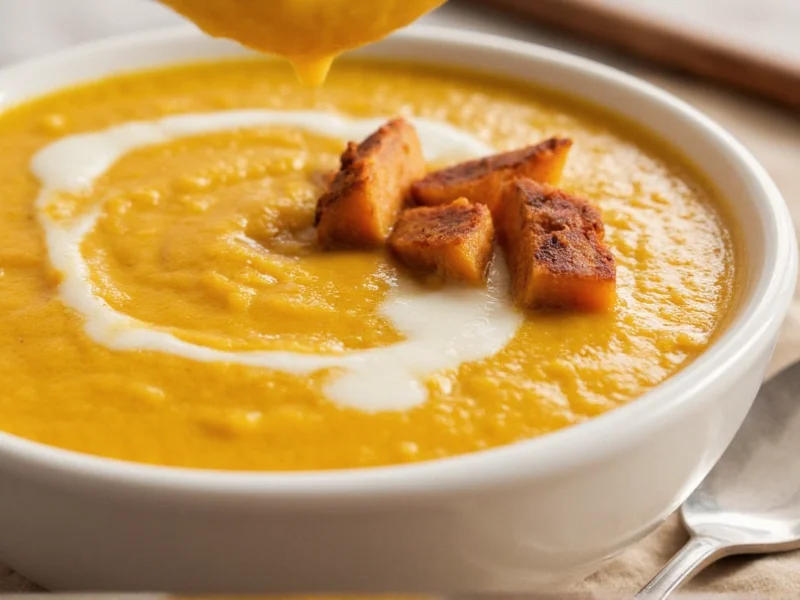This creamy butternut squash soup recipe delivers rich flavor with simple ingredients in just 45 minutes. The secret to perfect texture without heavy cream? Roasting the squash first and using vegetable broth as the base. This easy butternut squash soup recipe serves 4-6 and includes vegan and dairy options.
The Ultimate Homemade Butternut Squash Soup
Nothing says fall comfort like a warm bowl of butternut squash soup. This recipe has been perfected through years of testing to deliver maximum flavor with minimal effort. Unlike many recipes that rely on heavy cream for richness, ours achieves velvety texture through proper roasting technique and strategic ingredient pairing. Whether you're cooking for a weeknight dinner or holiday gathering, this easy butternut squash soup recipe delivers restaurant-quality results at home.
Why This Recipe Works
Most butternut squash soup recipes miss three critical elements that make the difference between good and exceptional:
- Proper roasting temperature (400°F) caramelizes natural sugars without burning
- Apple addition balances earthy squash with subtle sweetness
- Spice blooming in oil before adding liquid maximizes flavor extraction
These professional techniques transform simple ingredients into a complex, restaurant-worthy soup without requiring special equipment or hard-to-find ingredients.
Ingredients for Perfect Butternut Squash Soup
| Ingredient | Amount | Preparation Notes |
|---|---|---|
| Butternut squash | 2 lbs (about 1 medium) | Peeled, seeded, cubed 1-inch pieces |
| Yellow onion | 1 medium | Chopped |
| Garlic | 3 cloves | Minced |
| Fuji apple | 1 medium | Peeled, cored, diced |
| Vegetable broth | 4 cups | Low sodium preferred |
| Olive oil | 2 tbsp | Plus extra for roasting |
| Maple syrup | 1 tbsp | Optional for enhanced sweetness |
| Spices | 1 tsp each | Nutmeg, cinnamon, smoked paprika |
Step-by-Step Preparation
Roasting the Squash (Critical Step)
- Preheat oven to 400°F (200°C)
- Toss cubed squash with 1 tbsp olive oil, salt, and pepper
- Spread in single layer on parchment-lined baking sheet
- Roast for 25-30 minutes until fork-tender and caramelized at edges
Building Flavor Foundation
- In large pot, heat 2 tbsp olive oil over medium heat
- Add onions and sauté until translucent (5 minutes)
- Add garlic, spices, and apple; cook 3 minutes until fragrant (this blooming technique extracts maximum flavor)
- Add roasted squash and vegetable broth
- Simmer 15 minutes to blend flavors
Final Texture Perfection
- Carefully transfer to blender (or use immersion blender)
- Blend until completely smooth (critical for creamy texture)
- Return to pot, add maple syrup if using, and adjust seasoning
- For creamy butternut squash soup without cream, serve as is. For richer version, stir in 1/2 cup coconut milk
Pro Tips for Best Results
- Squash selection: Choose squash with dull, hard skin and heavy for its size
- Time-saver: Use pre-cubed squash (but expect slightly less flavor)
- Texture fix: If soup is too thick, add broth 1/4 cup at a time
- Flavor boost: Finish with fresh thyme and pumpkin seeds
Variations to Try
This best butternut squash soup recipe for fall adapts beautifully to different preferences:
- Vegan butternut squash soup recipe: Use coconut milk instead of dairy
- Spicy version: Add 1/4 tsp cayenne with spices
- Curried twist: Replace spices with 2 tbsp curry powder
- Protein boost: Stir in white beans before blending
Storage and Reheating Instructions
Proper butternut squash soup storage tips ensure maximum freshness:
- Refrigeration: Store in airtight container for up to 5 days
- Freezing: Freeze for up to 3 months (thaw overnight in fridge)
- Reheating: Warm gently over medium-low heat, stirring frequently
- Texture refresh: Add splash of broth when reheating if needed
Serving Suggestions
Elevate your how to make butternut squash soup from scratch experience with these pairings:
- Crusty artisan bread or garlic bread
- Simple green salad with apple cider vinaigrette
- Grilled cheese sandwich (try with gruyere cheese)
- Garnish with toasted pumpkin seeds and fresh thyme
Frequently Asked Questions
Can I make butternut squash soup without roasting?
Yes, but roasting dramatically improves flavor. If skipping roasting, sauté squash cubes in oil for 8-10 minutes before adding to soup. The soup will be less sweet and complex without the caramelization from roasting, but still delicious.
How do I prevent stringy texture in butternut squash soup?
Stringy texture comes from undercooked squash or improper blending. Ensure squash is fork-tender before blending, and blend while hot for 2-3 minutes until completely smooth. An immersion blender works better than regular blender for achieving silky texture.
What's the best way to cut butternut squash safely?
Peel with a sharp vegetable peeler, then cut off ends. Microwave whole squash for 2 minutes to soften, making it easier to cut. Slice in half lengthwise, scoop seeds with spoon, then cube. Always use a stable cutting board and keep fingers clear of blade path.
Can I use frozen butternut squash for this recipe?
Yes, frozen butternut squash works well. Thaw completely and pat dry before roasting. You may need to reduce roasting time by 5-7 minutes since frozen squash releases more moisture. The flavor will be slightly less sweet than fresh, but still excellent.
How can I make this soup thicker without adding starch?
Simmer uncovered for 10-15 minutes to reduce liquid. Alternatively, remove 1-2 cups of soup, blend with 1/4 cup cooked white beans, then stir back in. The beans add thickness and protein without altering flavor significantly.











 浙公网安备
33010002000092号
浙公网安备
33010002000092号 浙B2-20120091-4
浙B2-20120091-4